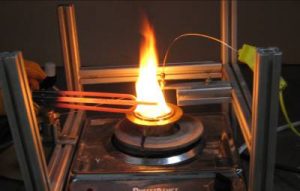 Railcar rubber products need to meet flame smoke, and toxicity (FST) standards that protect human health and safety. Fires that burn railcar seats, floors, wall panels, and other interior components don’t just cause immediate injuries and fatalities. Flames can release smoke that obscures escape routes. Burning rubber that releases toxic gases can also overwhelm passengers and employees.
Railcar rubber products need to meet flame smoke, and toxicity (FST) standards that protect human health and safety. Fires that burn railcar seats, floors, wall panels, and other interior components don’t just cause immediate injuries and fatalities. Flames can release smoke that obscures escape routes. Burning rubber that releases toxic gases can also overwhelm passengers and employees.
Suppliers offer compounds that meet FST standards, but design engineers still facing a challenging task. The flame, smoke, and toxicity standards for railcar materials vary widely. Designers need to familiarize themselves not just with different standards, but with standards used in different countries. By partnering with the right fabricator, however, you can source the right rubber products for sealing and insulation.
Understanding FST Standards
 Some FST standards reference three different tests from ASTM International, a leading international standards organization.
Some FST standards reference three different tests from ASTM International, a leading international standards organization.
ASTM E162 measures surface flammability.
ASTM E662 measures the specific optical density of smoke.
ASTM E1354 measures release rates for both heat and visible smoke.
Railcar rubber that passes all three ASTM tests may seem like a logical choice for your application, but these aren’t the only FST standards that apply to the mass transit industry. For example:
SMP 800-C from Bombardier measures toxic gas generation from gas combustion.
NF F 16-101 and NF F 16-102 are French national standards for fire-testing railway components.
BS 6853 is a British national standard for fire-testing railways parts.
Other countries have their own FST standards for railcar rubber, too. In addition, local or regional transit authorities can adhere to their own specifications. If your company does business in European Union (EU) countries, you may also need to consider how RoHS standards relate to rubber products.
Flame, Smoke, and Toxicity Tests
 Flame tests for railcar rubber can have important differences. For example, the ASTM E162 test evaluates railcar materials based on the spread of flame. By contrast, the British and French standards require elastomers to withstand exposure to a hot wire without ignition. Railcar rubber products that meet the French and British requirements must also meet or exceed a specified oxygen index.
Flame tests for railcar rubber can have important differences. For example, the ASTM E162 test evaluates railcar materials based on the spread of flame. By contrast, the British and French standards require elastomers to withstand exposure to a hot wire without ignition. Railcar rubber products that meet the French and British requirements must also meet or exceed a specified oxygen index.
Optical smoke density tests vary, but the differences are not as great. For example, both ASTM E662 and the French standard expose railcar rubber to combustion inside of a closed chamber. To determine the specific optical density, the percentage of light transmission that is lost is recorded. The French standard and ASTM E662 test take these measurements at different time intervals, however.
Toxicity measurements cannot exceed emissions limits for toxic gases or fumes. The French and British standards use the same test method, but the U.K. specification contains an addendum for nitrous oxides, gases that inflame the airways at high concentrations. The French and British standards use their test results to develop a constant, but SMP 800-C from Bombardier contains individual toxic gas requirements.
Railcar Rubber Products: FST and CTG Seals
 Elasto Proxy, a leading supplier of custom rubber products for the mass transit industry, can help you to select compounds that meet the specific FST requirements for your railcar application. We also support your material selection process by offering certified transit grade (CTG) rubber that was developed in partnership with a trusted, long-term supplier.
Elasto Proxy, a leading supplier of custom rubber products for the mass transit industry, can help you to select compounds that meet the specific FST requirements for your railcar application. We also support your material selection process by offering certified transit grade (CTG) rubber that was developed in partnership with a trusted, long-term supplier.
CTG seals from Elasto Proxy are made of an EPDM elastomer that has been tested and certified by an independent laboratory. Elasto Proxy supplied samples or specimens, and the laboratory conducted the following tests according to published standards from ASTM International and Bombardier, Inc.
ASTM E162
ASTM E662
ASTM E1354
SMP 800-C
In addition to meeting these FST requirements, CTG seals add value to your railcar application because Elasto Proxy fabricates these rubber products using water jet cutting and your choice of splicing techniques.
For more information about our railcar rubber products, contact Elasto Proxy.











